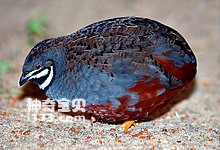Blue-breasted Quail (scientific name: Coturnix chinensis), also known as Osmanthus Sparrow and Rutin Chicken, is named after the bright blue feathers on the head and chest of the male individual. This small bird, which is distributed in southeastern my country, Southeast Asia and Oceania, belongs to the same family as the chickens we commonly eat.

The blue-breasted quail is the smallest in the quail world (but even though it is small, its English name is the domineering "king quail"). The adult blue-breasted quail is only 12 to 14 centimeters long and weighs about 40 grams, which is heavier than a mobile phone. Much lighter.
Blue-breasted Quail, female on the left and male on the right. The beautiful blue head and chest of the male blue-breasted quail, plus the reddish-brown color on the abdomen and the white ring on the neck, make the overall color scheme very beautiful. In addition to lacking the white ring on the neck, the female blue-breasted quail also has a relatively dull body color | Picture Chong Creative
Blue-breasted quail have a mixed diet and can eat everything from seeds to insects. Its reproduction is affected by climatic conditions. If the weather is suitable, it can reproduce almost all year round, but it is more common in autumn and winter, and each clutch can lay four to a dozen eggs. Blue-breasted quail mainly walks on land in the wild and can also fly short distances.
Artificial breeding of blue-breasted quail has a long history, and there are many places in my country that specifically raise blue-breasted quail for eggs. In an artificial breeding environment, through screening individuals with different colors and further crossbreeding and breeding, more than 15 color varieties of blue-breasted quail have been developed, and many of the color types can also be inherited stably.
animal tags: chicken
We created this article in conjunction with AI technology, then made sure it was fact-checked and edited by a Animals Top editor.